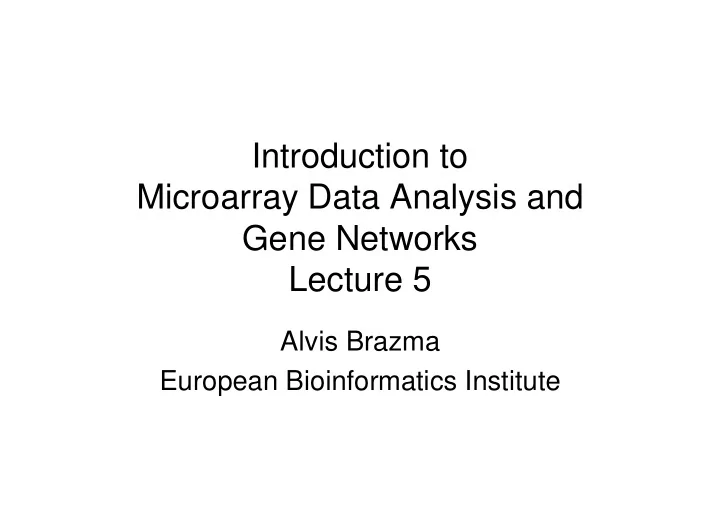

Introduction to Microarray Data Analysis and Gene Networks Lecture 5 Alvis Brazma European Bioinformatics Institute
Lecture 5 • Clustering – Hierarchical – K-means • A few minutes about representing experimental designs – Experiment design graphs, replicates – Experimental factors • A few minutes about supervised learning • Practical
Supervised vs. unsupervised analysis - class discovery vs. clustering
What is a cluster? •In a set of elements, subsets of elements that are in some sense closer to each other than ‘average’ •Closeness can be defined by a distance measure •Distance by itself is not sufficient •How to measure distance between more than 2 points? •Shape of the cluster? •Thresholds of closeness which are the same clusters, which are not
What is a cluster? The definition of what is a ‘cluster’ is difficult In practice it is defined by an algorithm that finds clusters
Clustering algorithms • Hierarchical vs flat – Hierarchical clustering builds a hierarchical tree (also called dendrogram) showing the relationship among the elements – Flat clustering partitions the set of elements in subsets (nonoverlapping or overlapping) 1 2 c2 c1 3 c5 c3 4 c4 5
Hierarchical clustering – how does it work? 1 1 2 2 1 2 1 3 3 4 4 3 2 4 5 3 5 5 4 1,2 3 4 5 1 2 3 4 5 1,2 3 4 5 5 2 1,2 4.5 5.5 1 2 5 6 2 1 1,2 4.5 5.5 3 3 3 2 2 4 5 3 3 3 4 2 3 3 3 4 2 5 4 2 5 5
Different linkages Keep joining together two closest clusters by using the: Minimum distance => Single linkage Maximum distance => Complete linkage Average distance => Average linkage Alternative – maintain a centroid in each cluster and use it for linking
Flat clusterings All genes TFIID SAGA
Clustering genes and smaples • When does it make sense to cluster samples?
K means clutering • K stands for number of clusters one wants to obtain – K has to be guessed • We need a notion of a gravity center – in n dimensional Euclidean space the gravity center of vectors (each of weight 1) is defined as the vector of mean coordinates along each dimension separately
B A C Condition 1 Condition 2 Figure 4.2
y A 5 A = (2,5) 4 B = (4,2) 3 C = (3,-3) B 2 1 X=(2+4+3)/3=3 x Y=(5+2-4)/3=1 0 1 2 3 4 -1 -2 -3 C -4 -5
y A 5 A = (2,5) 4 B = (4,2) 3 C = (3,-3) B 2 1 X=(2+4+3)/3=3 x 0 1 2 3 4 -1 -2 -3 C -4 -5
y A 5 A = (2,5) 4 B = (4,2) 3 C = (3,-3) B 2 1 X=(2+4+3)/3=3 x Y=(5+2-4)/3=1 0 1 2 3 4 -1 -2 -3 C -4 -5
y A 5 A = (2,5) 4 B = (4,2) 3 C = (3,-3) B 2 1 X=(2+4+3)/3=3 x Y=(5+2-4)/3=1 0 1 2 3 4 -1 G = (3,1) -2 -3 C -4 -5
K means clustering 1. Select K points (vectors) called centers in the space somehow (at random, or more intelligently so that they are far a way) 2. For each vector in the universe that you want to cluster, calculate the distance between it and all the K centers, and assign it to the center which is the closest - In this way K clusters are defined. 3. In each cluster define the new center as its gravity center 4. Repeat steps 2-3 until the gravity centers do not move any more, or after some fixed number of steps
1. Guess K centres 3. Move to gravity centres 2. Assign to clusters
K means clustering 1. Select K points (vectors) called centers in the space somehow (at random, or more intelligently so that they are far a way) 2. For each vector in the universe that you want to cluster, calculate the distance between it and all the K centers, and assign it to the center which is the closest - In this way K clusters are defined. 3. In each cluster define the new center as its gravity center 4. Repeat steps 2-3 until the gravity centers do not move any more, or after some fixed number of steps
Other clustering methods • Kohonen’s self organising maps • Self organising trees (Dopazo) • Probability distribution based clustering • Two way clustering • Fuzzy clustering • Cluster comparison
Recommend
More recommend